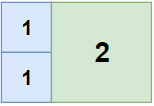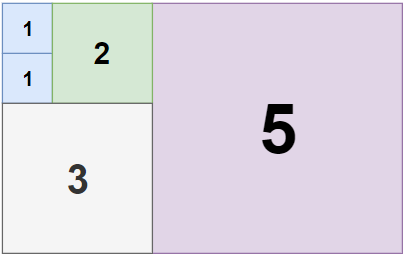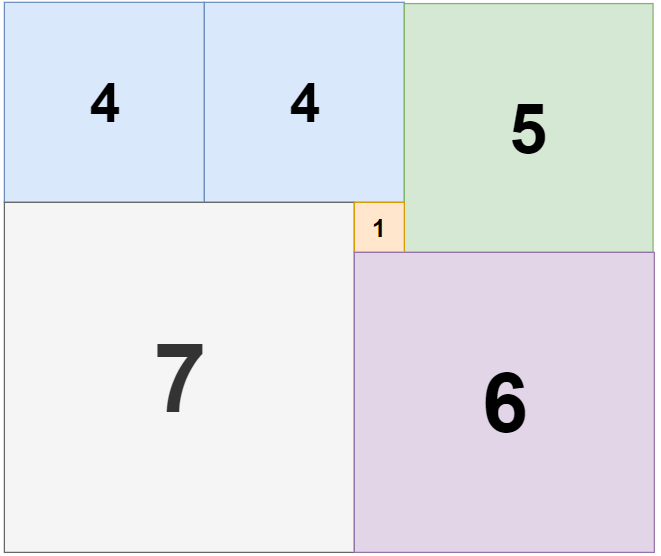- {x}
- Check If It Is a Straight Line
- Remove Sub-Folders from the Filesystem
- Replace the Substring for Balanced String
- Maximum Profit in Job Scheduling
- Web Crawler
- Find Positive Integer Solution for a Given Equation
- Circular Permutation in Binary Representation
- Maximum Length of a Concatenated String with Unique Characters
- Tiling a Rectangle with the Fewest Squares
- Number of Comments per Post
- Web Crawler Multithreaded
- Array Transformation
- Design A Leaderboard
- Tree Diameter
- Palindrome Removal
- Minimum Swaps to Make Strings Equal
- Count Number of Nice Subarrays
- Read More...

Tiling a Rectangle with the Fewest Squares
Given a rectangle of size n x m, return the minimum number of integer-sided squares that tile the rectangle.
Example 1:

Input: n = 2, m = 3 Output: 3 Explanation:3squares are necessary to cover the rectangle.2(squares of1x1)1(square of2x2)
Example 2:

Input: n = 5, m = 8 Output: 5
Example 3:

Input: n = 11, m = 13 Output: 6
Constraints:
1 <= n, m <= 13
1240. Tiling a Rectangle with the Fewest Squares
Problem Description
Given a rectangle of size n x m, find the minimum number of integer-sided squares needed to tile the rectangle.
Solution: Recursive Backtracking with Bit Manipulation
This problem can be efficiently solved using recursive backtracking combined with bit manipulation for state representation. The key idea is to explore all possible ways to place squares within the rectangle, keeping track of the minimum number of squares used.
State Representation:
We use a bitmask to represent the state of each row. Each bit in the bitmask corresponds to a column in the rectangle. A 1 indicates that the column is covered by a square, and a 0 indicates it's uncovered. An array of n integers (one for each row) is used to store the row states.
Recursive Backtracking:
The backtracking function dfs(i, j, t) explores the rectangle row by row, column by column:
-
Base Case: If
i == n, all rows are filled, so we've found a tiling. Update the minimum number of tiles (ans) and return. -
Row Transition: If
j == m, the current row is complete. Move to the next row (i + 1, 0). -
Skip Covered Cells: If the current cell (
i, j) is already covered (filled[i] >> j & 1), move to the next cell (i, j + 1). -
Explore Square Sizes: Otherwise, find the largest possible square that can be placed at (
i, j). This involves checking how many consecutive uncovered columns and rows are available starting from the current cell. The maximum side lengthmxis determined by the minimum of available rows and columns. -
Place Squares: Iterate through possible square sizes (
wfrom1tomx). For each size:- Update the
filledarray to mark the covered cells. - Recursively call
dfs(i, j + w, t + 1)to explore the next part of the rectangle. - Crucially, backtrack: Clear the cells covered by the current square to explore other possibilities.
- Update the
Time Complexity: The time complexity is exponential, O(nm * 2^(nm)) in the worst case because of the recursive exploration of all possible square placements. The actual runtime is significantly faster due to pruning (t + 1 < ans).
Space Complexity: O(n) for the filled array. The recursive call stack could also use O(n*m) in the worst case.
Code Implementation (Python)
class Solution:
def tilingRectangle(self, n: int, m: int) -> int:
ans = n * m
filled = [0] * n
def dfs(i, j, t):
nonlocal ans
if i == n:
ans = t
return
if j == m:
dfs(i + 1, 0, t)
return
if filled[i] >> j & 1:
dfs(i, j + 1, t)
return
if t + 1 >= ans:
return
r, c = 0, 0
for k in range(i, n):
if filled[k] >> j & 1:
break
r += 1
for k in range(j, m):
if filled[i] >> k & 1:
break
c += 1
mx = min(r, c)
for w in range(1, mx + 1):
for k in range(w):
filled[i + k] |= 1 << (j + w - 1)
filled[i + w - 1] |= (1 << w) - 1 << j
dfs(i, j + w, t + 1)
for k in range(w):
filled[i + k] ^= 1 << (j + w - 1)
filled[i + w - 1] ^= (1 << w) - 1 << j
dfs(0, 0, 0)
return ansThe code in other languages (Java, C++, Go, TypeScript) would follow a very similar structure, using bit manipulation and backtracking. The core logic remains consistent. Remember that the exponential nature of the solution makes it less efficient for significantly larger n and m values.